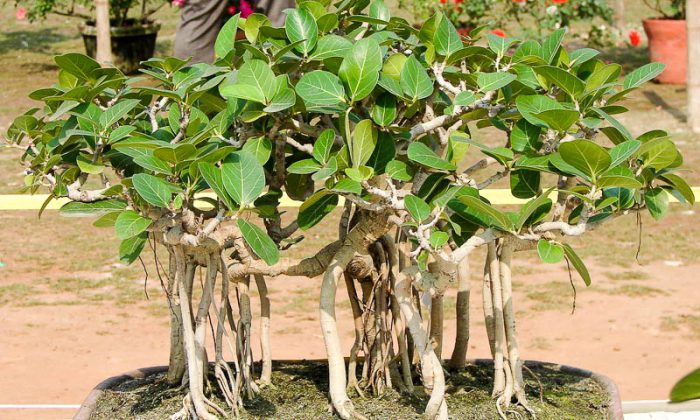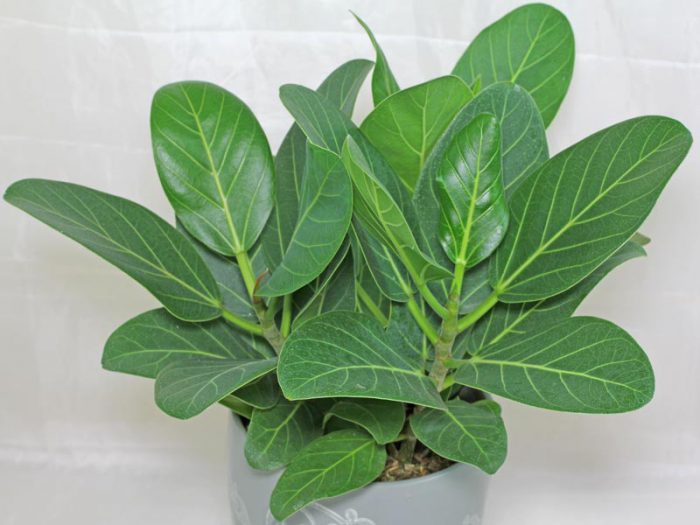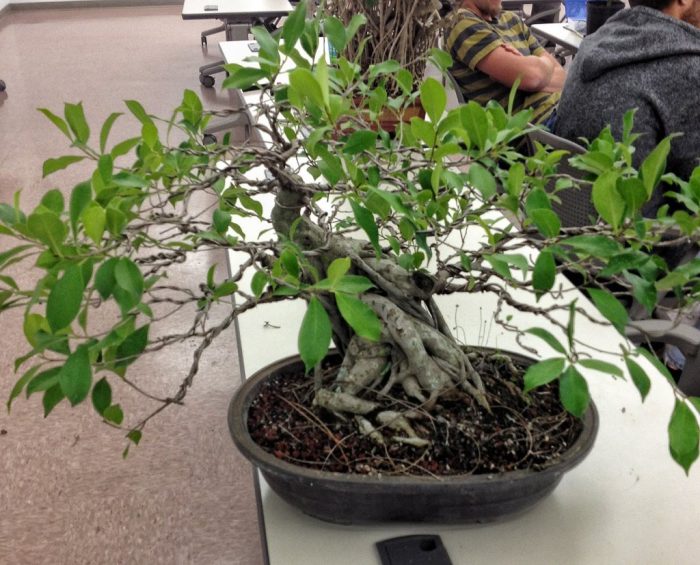A plant like Ficus bengal (Ficus benghalensis) belongs to the genus Ficus and to the mulberry family (Moraceae). This evergreen tree in nature can be found in monsoon wet forests, as well as the lower slopes of the mountains of Malaysia, Burma, India, Thailand and in other regions of southern China and Southeast Asia.
This plant is distinguished by its unique life form. Just one plant can grow so that it looks like there is a whole forest in front of you, consisting of trees close to each other. This unique growth form is called banyan tree. It all starts with the fact that the plant forms very thick airy roots, which are formed on horizontally located branches. Some roots dry out, while others rush to the surface of the soil. Then they take root and woody. After some time, they outwardly become similar to bearing trunks, while the roots themselves sprout side shoots. Thus, the ficus grows rather quickly in breadth, while capturing vast territories and forming a dense grove with unique ecosystems.
But not only ficus Bengal can form a banyan tree, there are other species capable of this. However, it is this plant that is the most powerful representative of the entire family. In nature, a tree can grow up to 40 meters. The foliage of the plant is also large - up to 25 centimeters in length. The leaves can have different shapes, for example: oval, simple, or ovoid. Pale green veins are clearly visible on the leathery green surface. During flowering, inflorescences characteristic only of this type appear, similar to small orange fruits that have the shape of a ball and reach a diameter of 2 or 3 centimeters.
The most popular are the varieties and varieties in which the foliage has a variegated color.
Content
Ficus Bengal care at home
This plant has a very effective appearance, but at the same time, special conditions are needed for its maintenance, and the main one is a spacious room. And that's all, because even in an apartment, this ficus is capable of reaching 3 meters in height and in width it also takes up a lot of space. If you decide to grow Bengal ficus, then you definitely need to remember a few rules for caring for it.
Illumination
In terms of lighting, this plant is completely undemanding. It is best to place it in a bright, spacious room.The required illumination level is 2600-3000 lux, which is observed in partial shade. It grows and develops quite well under artificial lighting.
In order for the crown of the plant to develop evenly, the flower pot must be rotated gradually around its axis from time to time.
Temperature regime
Needs moderate temperatures throughout the year. So, the temperature in the room where the tree is located should be from 18 to 26 degrees. He does not like drafts, especially if the air temperature is less than 17 degrees. His reaction may be to drop foliage.
How to water
This plant does not have a dormant period, so its watering should be the same both in winter and in summer. Water it abundantly and be sure to regularly. Between waterings, without fail, the upper layer of the substrate must dry out to a two- or three-centimeter depth.
Humidity
Since this plant is quite impressive in size, spraying it in order to increase air humidity is a laborious and almost meaningless process. It is recommended for Bengal ficus to periodically wipe the leaves using a soft cloth slightly moistened with water. This will freshen up the plant, and you can also clear it of accumulated dirt.
In winter, with the onset of the heating season, the plant must be rearranged away from heating appliances. However, make sure that the illumination remains within the normal range.
Fertilizer
Fertilize the plant carefully once every 2 or 4 weeks. To do this, use universal granular fertilizers (1/2 part of the recommended dose on the package).
Earth mixture
Suitable soil should be neutral or slightly acidic, sufficiently dense and rich in nutrients. You can buy a ready-made soil mixture for ficuses or, if you wish, make it yourself. To do this, it is necessary to combine leaf, turf and peat land, as well as sand, taken in equal shares. Don't forget a good drainage layer.
Transplant features
Young plants are transplanted once a year, while taking a larger pot. And in adult plants of impressive size, you just need to regularly change the top layer of the substrate.
It is a fast growing plant. So, in 12 months it can increase its height by 60-100 centimeters. In order to restrain the growth of this plant, you need to choose rather tight pots for planting it, and also during the transplant, you should slightly cut the root system.
Pruning
Ficus has a positive attitude towards formative pruning. Thanks to her, the plant will be able to acquire a spectacular lush crown and somewhat reduce its size.
Reproduction methods
Reproduction by cuttings is very popular. For this, the apical parts of the stems with 2 or 3 internodes are cut off. This procedure is carried out in the spring and summer. For rooting, cuttings are planted in a mixture of sand and peat. Cuttings also root in water, but the appearance of roots will occur somewhat later.
Florists with considerable experience behind them can use seeds or cuttings for reproduction.
Diseases and pests
The plant can settle shield, thrips or spider mite, but this happens quite rarely. If pests are found, the ficus should be given a warm shower. If the plant has impressive size, then its leaves must be thoroughly washed with a sponge soaked in water, and then treated with a special chemical agent.
Plants get sick in most cases due to violation of the rules of care:
- young ficuses have foliage withering - the room is very cold;
- yellowish spots appeared on the leaves - due to excessive watering;
- brownish spots appeared along the edge - low air humidity, too hot or a lot of fertilizer was applied to the soil;
- the leaves become smaller, and the stems are stretched - there is little light;
- growth becomes slow, and the leaves lose their rich color - it needs feeding.
Bonsai
It is almost impossible to grow ficus in an apartment in the form of a banyan tree, since it needs a lot of space and special conditions. But such a plant looks no less impressive in the form of a bonsai. Such ficus can be grown even in a relatively small room by placing it on a special stand or windowsill.















